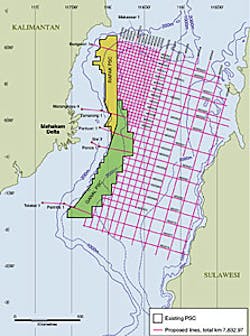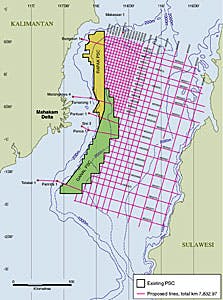GEOSCIENCES
Victor Schmidt
Houston
Indonesian deepwater survey
TGS-NOPEC began a new non-exclusive 2D survey offshore the Mahakam Delta off east Kalimantan, Indonesia. The survey is being done in cooperation with Minyak dan Gas Bumi (MIGAS) and Pertamina. The Odin Explorer will collect about 8,000 km of new data using a 6,000 km digital streamer. The survey is in the deepwater areas of the Kutei and Lariang basins east of Unocal's recent major discoveries, West Seno and East Seno. Water depths in the area approach 4,000 ft.TGS-NOPEC began an 8,000 km non-exclusive 2D survey in the deepwater basins off east Kalimantan, Indonesia.The exploration targets are turbidite sands associated with the Miocene paleo-Mahakam Delta. The new survey will be completed by late May 1999 and will be available to evaluate new acreage scheduled for release in the fourth quarter of 1999.
Oxy sets up vision center
Occidental Petroleum established a visualization center in Houston using a Silicon Graphics Onyx2 supercomputer. The system uses four processors running two InfiniteReality data pipes. An LCD projector casts an image on an 8 ft by 20 ft PowerWall for collaborative visual computing. Data models are held on a 156 gigabyte Fiber Channel RAID disk array. Secondary light-guide pipes connect other interpretation workstations to the supercomputer.Jack Miller, Senior Vice President Worldwide Exploration, explains: "This is a breakthrough for Occidental that will lead to fundamental changes in our work processes through collaboration among geologists, geophysicists, and engineers to enhance the quality and speed of decision-making." The new center will reduce the time required to reach competitive investment decisions. Fourteen professionals will work in the new Houston center.
A second center was recently installed for the headquarters office in Bakersfield, California. It uses a similar Onyx2 supercomputer but has more processing power.
NASA tracking natural oil seeps
NASA is teaming with industry to identify natural marine oil seeps in the Gulf of Mexico. The Commercial Remote Sensing Program at Stennis Space Center in Mississippi (US) coordinates the partnership between the Earth Observation Commercial Application Program (EOCAP) and the Earth Satellite Corp (EarthSat) of Rockville, Maryland (US).To detect oil seeps, the radar data measures changes in the texture of the ocean surface. A thin oil layer on the water dampens the small waves, making the radar images of the slick appear dark.
"Oil seep detection is a market that has not been addressed by any other EOCAP partnerships," said Mark Mick, EOCAP Manager at Stennis. "I also think it is a good application for remote sensing technology." The technique is less expensive than aerial surveys by plane and it allows oil companies to concentrate their exploration in the most likely oil-rich areas.
Largest 2D survey in the US Gulf
TGS-NOPEC and Schlumberger Geco-Prakla announced the completion of the Phase 45, non-exclusive, 2D-seismic program in the Gulf of Mexico (GOM). This joint venture consists of over 99,000 km of 2D data in the deepwater GOM and is believed to be the largest single 2D seismic program ever acquired.TGS-NOPEC and Schlumberger Geco-Prakla completed Phase 45 in the Gulf of Mexico deepwater. It may be the largest 2D survey ever acquired totaling over 99,000 line-km.Acquisition of the data began on October 20, 1995. Data delivery began in the spring of 1996. By the time data acquisition was completed on October 19, 1998 (three years later), five different seismic vessels and over 450 employees had contributed to this massive project. The final shipment of processed data was delivered to participating oil companies on December 31, 1998.
West African 3D seismic success
Mobil Producing Nigeria has increased its crude oil production by 120%, to 800,000 b/d, by applying 3D seismic technology to field development. Using 3D seismic, Mobil chose horizontal well technology to develop and extend its fields. This has made Mobil the second highest crude oil producer in Nigeria.In one field Mobil's production grew from 30,000 b/d in 1989 to 130,000 b/d in 1998 through a 36-hole horizontal-well program based on 3D seismic. The technology has raised Mobil's Nigerian crude oil reserves to 2.9 billion bbl. Nigeria has set a production target of 4-million b/d with 40 billion bbl in reserves by the year 2010.
Landmark introduces Release 98
Landmark Graphics has a fully integrated information solution, Release 98, that will allow teams of geoscientists, engineers, system administrators and managers to effectively explore, drill, and produce oil and gas reserves. Landmark's Unix and Windows applications have had over 300 enhancements to more than 50 applications in the suites.John W. Gibson, Executive Vice President said, "The software provides improvements to performance by 200% or greater for initialization across applications. We've combined new functionality, enhanced performance, and more tightly integrated technology across our suite of applications." The suite includes SeisWorks, StratWorks, Z-MAP Plus, petroWorks, Stratamodel, and VIP.
A Y2K compliant UNIX version, Release 98Plus, is also shipping. Keith Johnson, Director of Landmark's Y2K customer program, said "the Year 2000 issue presents a unique challenge to the E&P industry, in that every customer - worldwide - will need to upgrade concurrently." This new release adheres to the British Standards Institute Year 2000 Conformity guidelines.
NPTO releases more software
Twenty free programs are available from the National Petroleum Technology Office (NPTO), a subunit of the Department of Energy. Software can be downloaded directly off the NPTO website. A complete catalog of software and manuals is available on the website at www.npto.doe.gov/ software/software.html. Commercial software is also available for sale. For additional information contact Chandra Nauriyal at Tel 918-699-2021.Copyright 1999 Oil & Gas Journal. All Rights Reserved.


